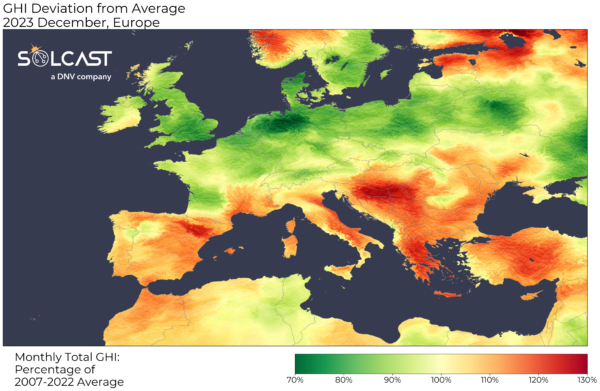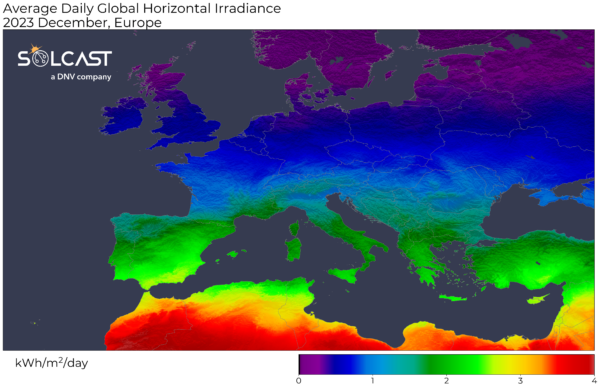A series of intense low pressure systems extending from the Baltics to the UK pulled moisture off of the Atlantic, bringing cloud and resulting in lower irradiance over Northern, Central and Western Europe this December. This increased cloud led to solar assets in Northern Germany and the Netherlands receiving only 70% of normal irradiance, according to data collected by Solcast, a DNV company, via the Solcast API. Due to short winter days, this is off of an extremely low base average.
This cloud activity did not make it below the Alps, and Southern Europe saw reduced rain and significantly less cloud than normal, with some regions experiencing 130% of the normal December irradiance.

Despite the cold and snowy start to the month, with heavy snowfall bringing both reduced irradiance and snow soiling for solar assets, most of the continent saw a relatively mild month. This pattern is in line with a normal El Nino year, typically seeing milder and wetter weather to the start of winter in Northern Europe, becoming colder and drier as the months continue. Southern Europe also saw warmer than normal temperatures, following the trend of 2023 as the hottest year on record and approaching a 1.5-degree increase from climatological averages.

While solar production in Northern Europe was suppressed, December saw records for wind power fall due to the strong winds driven by several significant storms. Late in the month Storms Pia and Gerrit disrupted holiday travel plans but also helped both the UK and Germany reach new records for wind generation. This helped Germany keep on track to exceed 50% of power from renewable sources across 2023, despite the reduced contribution from Solar generation in winter.
The effects of these storms were significant, as you can see from the below daily GHI image from December 21st, cloud associated with Storm Pia blocked irradiance from Scotland to the Pyrenees.

Image: Solcast
Solcast produces these figures by tracking clouds and aerosols at 1-2km resolution globally, using satellite data and proprietary AI/ML algorithms. This data is used to drive irradiance models, enabling Solcast to calculate irradiance at high resolution, with typical bias of less than 2%, and also cloud-tracking forecasts. This information is used by more than 300 companies managing over 150 GW of solar assets throughout the world.
The views and opinions expressed in this article are the author’s own, and do not necessarily reflect those held by pv magazine.
This content is protected by copyright and may not be reused. If you want to cooperate with us and would like to reuse some of our content, please contact: editors@pv-magazine.com.



By submitting this form you agree to pv magazine using your data for the purposes of publishing your comment.
Your personal data will only be disclosed or otherwise transmitted to third parties for the purposes of spam filtering or if this is necessary for technical maintenance of the website. Any other transfer to third parties will not take place unless this is justified on the basis of applicable data protection regulations or if pv magazine is legally obliged to do so.
You may revoke this consent at any time with effect for the future, in which case your personal data will be deleted immediately. Otherwise, your data will be deleted if pv magazine has processed your request or the purpose of data storage is fulfilled.
Further information on data privacy can be found in our Data Protection Policy.